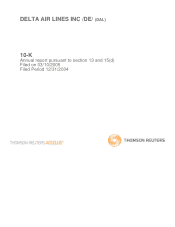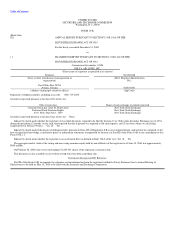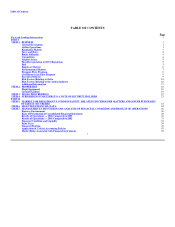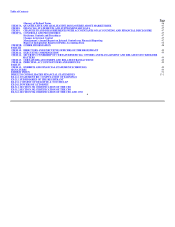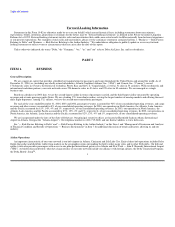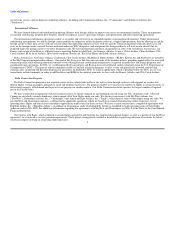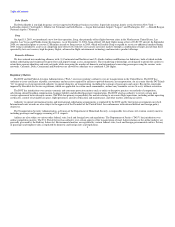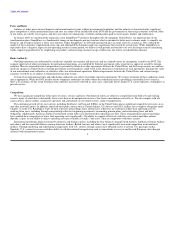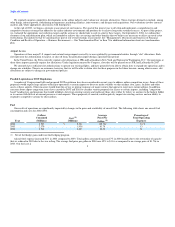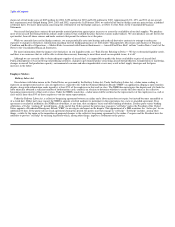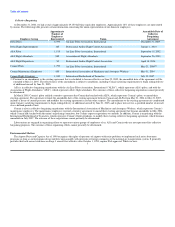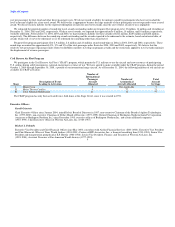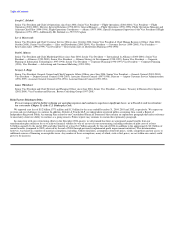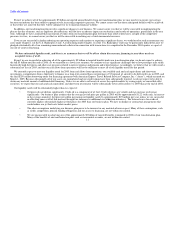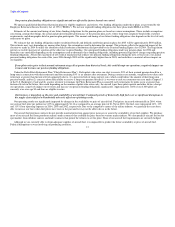Delta Airlines 2004 Annual Report Download - page 8
Download and view the complete annual report
Please find page 8 of the 2004 Delta Airlines annual report below. You can navigate through the pages in the report by either clicking on the pages listed below, or by using the keyword search tool below to find specific information within the annual report.
Table of Contents
Fares and Rates
Airlines set ticket prices in most domestic and international city pairs without governmental regulation, and the industry is characterized by significant
price competition. Certain international fares and rates are subject to the jurisdiction of the DOT and the governments of the foreign countries involved. Most
of our tickets are sold by travel agents, and fares are subject to commissions, overrides and discounts paid to travel agents, brokers and wholesalers.
In January 2005, we announced the expansion of our SimpliFaresTM initiative throughout the 48 contiguous United States. An important part of our
transformation plan, SimpliFares is a fundamental change in our domestic pricing structure which is intended to better meet customer needs; to simplify our
business; and to help us achieve a lower cost structure. Under SimpliFares, we lowered unrestricted fares on some routes by as much as 50%; reduced the
number of fare categories; implemented a fare cap; and eliminated the Saturday-night stay requirement that existed for certain fares. While SimpliFares is
expected to have a negative impact on our operating results for some period, we believe it will provide net benefits to us over the longer term by stimulating
traffic; improving productivity by simplifying our product; and increasing customer usage of delta.com, our lowest cost distribution channel.
Route Authority
Our flight operations are authorized by certificates of public convenience and necessity and, to a limited extent, by exemptions issued by the DOT. The
requisite approvals of other governments for international operations are controlled by bilateral agreements with, or permits or approvals issued by, foreign
countries. Because international air transportation is governed by bilateral or other agreements between the United States and the foreign country or countries
involved, changes in United States or foreign government aviation policies could result in the alteration or termination of such agreements, diminish the value
of our international route authorities or otherwise affect our international operations. Bilateral agreements between the United States and various foreign
countries served by us are subject to renegotiation from time to time.
Certain of our international route and codesharing authorities are subject to periodic renewal requirements. We request extension of these authorities when
and as appropriate. While the DOT usually renews temporary authorities on routes where the authorized carrier is providing a reasonable level of service,
there is no assurance of this result. Dormant route authority may not be renewed in some cases, especially where another U.S. carrier indicates a willingness to
provide service.
Competition
We face significant competition with respect to routes, services and fares. Our domestic routes are subject to competition from both new and existing
carriers, many of which have substantially lower costs than we do and provide service at low fares to destinations served by us. We also compete with all-
cargo carriers, charter airlines, regional jet operators and, particularly on our shorter routes, surface transportation.
The continuing growth of low-cost carriers, including Southwest, AirTran and JetBlue, in the United States places significant competitive pressures on us
and other network carriers. In addition, other hub-and-spoke carriers such as United Airlines, US Airways and ATA Airlines have sought to reorganize under
Chapter 11 of the U.S. Bankruptcy Code. In their respective proceedings, these airlines have reduced or are seeking to reduce their operating costs by
reducing labor costs, including through renegotiating collective bargaining agreements, terminating pension plans, and restructuring lease and debt
obligations. Additionally, American Airlines restructured certain labor costs and lowered its operating cost base. These reorganizations and restructurings
have enabled these competitors to lower their operating costs significantly. Our ability to compete effectively with low-cost carriers and other airlines
depends, in part, on our ability to achieve operating costs per available seat mile ("unit costs") that are competitive with those carriers.
International marketing alliances formed by domestic and foreign carriers, including the Star Alliance (among United Airlines, Lufthansa German Airlines
and others) and the oneworld alliance (among American Airlines, British Airways and others), have significantly increased competition in international
markets. Through marketing and codesharing arrangements with U.S. carriers, foreign carriers have obtained access to interior U.S. passenger traffic.
Similarly, U.S. carriers have increased their ability to sell international transportation such as transatlantic services to and beyond European cities through
alliances with international carriers. 4

